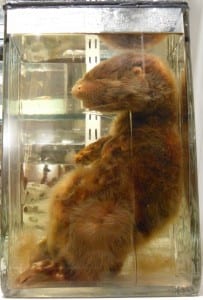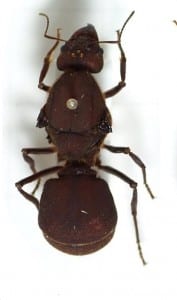A year in Show’n’Tell
By Dean W Veall, on 24 July 2014
Dean Veall here. This year we have given researchers from across UCL the chance to rummage through our drawers and delve into our cupboards as part of a brand new series of lunch time events, Show’n’Tell. The researchers had one task, to find just one object out of our 68,000 to show audiences and tell them all they know about it. Through these events we aimed to showcase the amazing research that is going on here at UCL and the passions driving some the people who work here. Some of the specimens chosen by researchers have directly related to their work whilst other have been a bit more left-field. As I get ready to host our last Show’n’Tell before the Summer break I thought it would be a good opportunity to look back on the specimens that we have had so far this year.
Brendan Clarke – Ziegler Wax Models
Kicking off our new event series was Dr. Brendan Clare from the Department of Science and Technology Studies. Brendan’s research is focused on the history of anatomical illustrations and models and because of that he knew instantly what he would choose for his Show’n’Tell, the Ziegler wax models. Brendan shared the history of these models and how the German father and son team of Adolf and Freidrich Ziegler rose to prominence for the mass production of models that were used in the teaching of the emerging science of developmental biology in the mid to late 19th Century.
To find out more about Brendan’s work follow him on Twitter @philmedman
Ben Garrod – Walrus (Odobenus rosmarus) skull
A PhD student at the Department of Genetics, Evolution and the Environment, Ben is investigating the morphological differences of green monkeys (Chlorocebus sabaeus) introduced to islands in the Caribbean in the 18th and 19th Centuries and their native range in West Africa. Spending the last three years of his life laser scanning the skulls of green monkeys to discover differences in their features clearly had an effect on Ben as he eschewed our primates and chose the walrus skull to share with the audience. Why a walrus? Well it is mostly to do with Ben’s long held passion for all things osteological, as not only is Ben an evolutionary scientist but you may have spotted him presenting BBC’s The Secrets of Bones this year, some of which was filmed in the Grant.
To find out more about Ben’s work follow him on Twitter @ben_garrod
Suzanne Harvey – Bisected chimpanzee (Pan troglodytes) head
Suzanne was coming to the end of her PhD in the Department of Anthropology when she joined us for our January event. Over the last three years Suzanne has been studying primate communication, specifically the vocal repertoire of olive baboons (Papio anubis). Suzanne shared some of her experience out in the field in Nigeria spending months at a time following groups of baboons, recording their calls and the behaviour associated with them. Interested in vocalisation in primates Suzanne chose the bisected chimp head that is part of the Negus Collection to illustrate the difference between the position of the larynx in primates and that of other animals which helps primates produce a greater range of calls.
To find out more about Suzanne’s work follow her on Twitter @suzemonkey
Alison Fairbrass – Preserved otter (Lutra lutra)
Urban biodiversity is the focus of Alison’s PhD at the Centre for Biodiversity and Environment Research (CBER) and the Engineering Department. Looking specifically at green infrastructure in cities Alison has been developing recording methods that involve sound to better monitor the wildlife that us Londoners share our city with. The one specimen Alison wanted to share with the audience was the otter, using it to highlight the remarkable comeback this species has made since being on the brink of extinction only 50 years ago. Otters are even being found in cities such as Bristol, she has yet to spot one on the Thames but thinks it will only be a matter of time.
To find out more about Alison’s work follow her on Twitter @alisonfairbrass
Henry Ferguson-Gow – Leafcutter ant (Atta sexdens)
Ants! Over three years as a PhD student at CBER Henry Ferguson-Gow has been single minded in his work on this fascinating group of animals. He has been working on the evolution of eusociality, a complex social organisation of some insects where there involves a strict division of labour. Henry shared some extreme examples of eusociality in ants featuring some great images by Alex Wild, but for him it was the leafcutter ant queen that best highlighted his work studying the evolution of this behaviour, as this species exhibits some major physical differences between the different castes of ants.
Elizabeth Jones – Thylacine (Thylacinus cynocephalus) skeleton
Having only gone extinct in 1936 the thylacine plays an important role in understanding our role in species extinction. Elizabeth Jones from the Department of Science and Technology Studies chose this specimen for her Show’n’Tell back in June. Elizabeth is studying the history of the research of ancient DNA and shared some of her work interviewing the scientists who were the first to start investigating the possibility of extracting DNA from extinct material. The first studies focused on the quest to find the ‘oldest’ DNA but Elizabeth chose this specimen as some of the best research in the field was done using recently extinct animals such as the thylacine.
To find out more about Elizabeth’s work follow her on Twitter @edobsonjones
Clare Duncan – Ganges River Dolphin (Platanista gangetica) skeleton
Clare’s PhD is split between UCL’s Geography Department and the Institute of Zoology based at the Zoological Society of London where she is researching the conservation of mangroves using practical programmes and Earth observation imagery. Clare joined us just before she was heading out to the the Philippines for three months on her first field study. The Ganges river dolphin was Clare’s choice because she felt there were lots of assumptions that these ecologically important habitats were poor in terms of biodiversity but the Sunderbans in Bangladesh are hotspots with the world’s largest population of Royal Bengal tigers and home to this freshwater dolphin.
To find out more about Clare’s work follow her on Twitter @whereisklara
Helen Meredith – Surinam toad (Pipa pipa)
Helen has spent the last three years of her PhD at the Institute of Zoology and CBER studying amphibian conservation and methods to improve the impacts of that work. Amphibians as a group have been under resourced in terms of conservation despite being the most threatened vertebrate group. As part of her work Helen has been working with conservationists to better understand what success means for their work, whether it is simply increasing numbers of individuals or a mixed approach including community education and engagement as well as critically reviewing projects to find examples of evidence based conservation. The Surinam toad was her choice as she felt it represented the reason amphibians are so poorly appreciated, it has a reproductive habit that some might balk at but Helen thought was remarkable. The female Surinam toad’ eggs once fertilised get embedded on the skin of her back with the young developing and bursting out of the skin as froglets.
Our final Show’n’Tell is this Friday 25th July, join us from 1pm to find out more about the Okavango delta with Luca Marazzi and what he chose out of the 68,000 specimens in the collection.
Dean Veall is Learning and Acess Officer at the Grant Museum of Zoology
One Response to “A year in Show’n’Tell”
- 1
 Close
Close










[…] Veall here. Over the last year I’ve been hosting our new lunch hour event series Show’ n ‘ Tell, with PhD students from across UCL sharing some of their amazing research and choosing just one […]